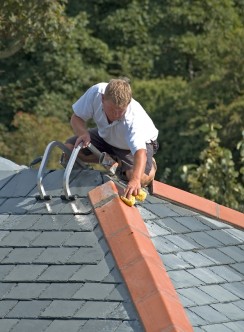THURSDAY, APRIL 4, 2013
An unhappy scenario that some homeowners have experienced is a roof cave in. This is a serious emergency situation that can be caused by things like storms, strong winds, tree branches, or damage from animal pests.

Whether or not your homeowner's insurance policy will cover the damage depends on a number of factors. Policies take the age of the roof into account, and you may only receive reimbursement for the depreciated value. If you sustain damage that is determined to be from lack of roof maintenance that has led to wear and tear or poor condition of the roof, your policy may limit coverage. A roof that has not been maintained can also leak and cause internal problems that can go unnoticed until damage to your house and contents is extensive.
Keeping your roof in good shape, therefore, makes sense, and there are some good maintenance practices that will keep your roof healthy and prevent problems. The best time to do roof maintenance is in the spring.
Spring maintenance is particularly important if you live in cold climates, since snow, ice and melting can cause serious damage. Roof problems can be a consequence of inadequate home ventilation, which allows heat to escape through the roof. Not only will this shorten the lifespan of your roof, it wasted energy dollars.
Unfortunately, most people don't know what condition their roof is in because they have never climed a ladder and actually looked. The most important part of good preventive maintenance for your roof is to take a look. Depending on what you find in your maintenance check, you may be facing minor repairs or more extensive roof work.
Many issues are simple do-it-yourself projects, while others may require the services of a professional. Safety is always a consideration, of course, and if your roof is too high or steep, then you should hire a professional to perform the assessment. Good spring roof maintenance, however, is your best prevention against emergency repairs.
Good maintenance practices will also extend the lifespan of your roof, saving you money on roof replacement costs.
Spring Maintenance Checklist:
1. Look at the ceiling inside. Any stains or spots could be evidence of water damage, indicating loose flashing (metal strips that seal connections) or shingle cracks or leaks. They can also be a sign of ice dams, which could mean a problem with insulation or poor home ventilation.
2. Shingle/tile check. Look for any missing shingles, and examine shingle condition for any that are peeling, cracking, or losing their grain. Asphalt shingles that are losing their grain are in danger of starting to crack and peel with exposure to sunlight. A few damaged shingles can be easily replaced, but many shingles in poor condition means a complete re-roofing is needed. Curling shingles could also be a sign of inadequate roof ventilation.
3, Clean the shingles. If moss or algae is growing on or between the shingles, this needs to be removed. This can be done by spraying moss remover solution on the roof, then using a broom to remove the growth. Serious mold or rot needs to be addressed immediately by a professional, as the roof may need replacing.
4. Shingle granule buildup. Excessive granules in gutters, downspouts and around the roof area are a sign that the shingles are worn and need replacing to prevent leakage.
5. Chimney and skylight. Check flashing connections between skylight, chimney and roof. Snow and wind can cause flashing to loosen and leak. Repair or replace any damaged flashing strips and seal cracks. Check the masonry joints of the chimney for damage or presence of efflorescence, a calcium deposit that could indicate water leaks.
6. Roof bolts. If you have a metal roof, check for any loose metal bolts and tighten them.
7. Gutters and downspouts. Examine the home siding for any evidence of water damage. Climb the ladder and use a trowel to scoop out debris, dirt and leaves out of the gutters. Tighten any spots where the gutter had come loose and flush any residue with the garden hose. Flush downspouts.
8. Soffit and Fascia. The vents in soffit and fascia are a favorite nesting place for small animals, who are drawn by the warm air. Come spring, these critters begin to reproduce, and if they find a way inside, you could be looking at serious damage inside your attic and home.
9. Yard assessment. Remove any dead tree limbs near the roof and trim overhanging branches.
For more tips, tricks, or better yet, to get a free insurance quote, give Bramlett Personal Risk Advisor, Leslie Hicks at call at (580) 223-7300.
No Comments
Post a Comment |
|
Required
|
|
Required (Not Displayed)
|
|
Required
|
All comments are moderated and stripped of HTML.
|
|
|
|
|
|
NOTICE: This blog and website are made available by the publisher for educational and informational purposes only.
It is not be used as a substitute for competent insurance, legal, or tax advice from a licensed professional
in your state. By using this blog site you understand that there is no broker client relationship between
you and the blog and website publisher.
|
Blog Archive
2017
2016
2015
2014
2013
2012
|